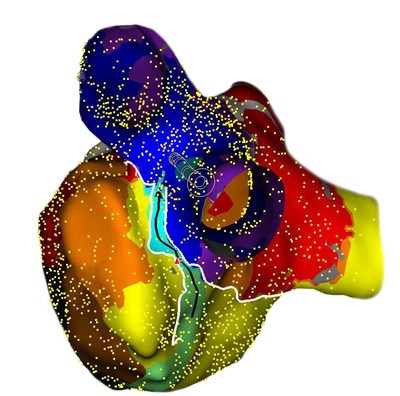ABBOTT PARK, Ill., Jan. 12, 2017
/PRNewswire/ -- Abbott (NYSE: ABT) announced today the U.S.
launch and the first commercial uses of the new EnSite Precision™
cardiac mapping system and Advisor™ FL Circular Mapping Catheter,
Sensor Enabled™ to map cardiac arrhythmias during ablation
treatments. The first commercial use of the system after U.S. Food
and Drug Administration clearance occurred at the Intermountain
Heart Institute at Intermountain Medical Center in Salt Lake City during ablation procedures
conducted by electrophysiologist John
Day, M.D.
Since the landmark clinical cases by Dr. Day, additional
procedures supported by the new EnSite Precision cardiac mapping
system have occurred in 12 states nationwide, supporting ablation
procedures to treat complex arrhythmias. Abbott expects its new
cardiac mapping technology to quickly become a new standard for use
in treating patients experiencing arrhythmias from multiple origins
in the heart. In the coming weeks, physicians across the country
will begin to use the EnSite Precision cardiac mapping system.
"The new EnSite Precision cardiac mapping system allows better
three-dimensional images of the arrhythmias in the heart, which
improve the accuracy of what we see during the procedure so we can
more precisely treat the patient," said Dr. Day, medical director
of the Intermountain Heart Rhythm Specialists at the Intermountain
Medical Center Heart Institute. "We were excited to perform the
inaugural case in the United
States, and we continue to utilize the system daily to
provide the best patient care possible."
When physicians use catheter ablation to treat abnormal heart
rhythms, a small area of heart tissue under the tip of the ablation
catheter is heated by radio-frequency energy, creating a lesion or
tiny scar. As a result, this tissue is no longer capable of
conducting or sustaining the arrhythmia. Cardiac mapping provides
an inside view of the heart so physicians can visualize and
navigate cardiac anatomy to deliver more precise ablation
therapy.
Built on a foundation of the St. Jude Medical™ cardiac mapping
technology utilized in more than 2,000 electrophysiology labs
around the world, the new EnSite Precision cardiac mapping system
is the latest addition to the company's electrophysiology
portfolio. This next-generation technology is designed to provide
automation, flexibility and precision in cardiac mapping during the
treatment of patients with abnormal heart rhythms (cardiac
arrhythmias). Its dual-technology platform provides highly detailed
anatomical models and maps to enable more efficient treatment of a
wide range of irregular heart rhythms — including complex
arrhythmias, such as atrial fibrillation or ventricular
tachycardia.
The EnSite Precision cardiac mapping system introduces new
solutions, including the EnSite™ AutoMap Module, which enables the
electrophysiologist to more quickly perform morphology matching
that identifies the source of the irregular heartbeat. The EnSite
AutoMap Module includes the new TurboMap feature, which allows the
physician to build a map of the heart 10 times faster than current
systems using recorded data.
"This next generation technology was designed in collaboration
with some of the world's leading electrophysiologists so that they
can quickly and precisely identify the source and substrate source
of a patient's irregular heartbeat," said Srijoy Mahapatra, M.D.,
medical director and vice president of Medical Affairs for Abbott's
electrophysiology business. "We expect the EnSite Precision cardiac
mapping system to become the new standard for identifying abnormal
heart rhythms when tailoring treatment for patients suffering from
arrhythmias."
ABOUT THE ENSITE PRECISION CARDIAC MAPPING SYSTEM
The EnSite Precision cardiac mapping system is flexible and
enhances workflow efficiency by allowing physicians to map heart
chambers with any electrophysiology catheter and customize
procedures to address the circumstances of each case. The EnSite
Precision cardiac mapping system and the company's sensor enabled
tools also allow catheter navigation to occur with minimal
fluoroscopy, thus reducing potential for risks associated with
excessive radiation exposure.
ABOUT CARDIAC ABLATION
When physicians use catheter ablation to treat abnormal heart
rhythms (arrhythmias), several long, flexible tubes with wires —
called catheters — are inserted into the heart. Diagnostic
catheters record electrical information from the heart and display
it in a three-dimensional anatomical model, which is used to study
the abnormal rhythm.
Another catheter is used for the actual ablation. The doctor
positions the ablation catheter so it lies on or very close to the
targeted tissue. The small area of heart tissue under the tip of
the ablation catheter is heated by radio frequency energy, creating
a lesion or tiny scar. As a result, this tissue is no longer
capable of conducting or sustaining the arrhythmia.
ABOUT THE ABBOTT ELECTROPHYSIOLOGY (EP) BUSINESS
The Abbott electrophysiology (EP) business is one of the fastest
growing segments within the company's broader device portfolio. The
Abbott EP product portfolio gives physicians the diagnostic,
access, mapping and therapy solutions they need with designed
integration for enhanced diagnosis and treatment of heart
arrhythmias. A leader in collaborating with world-renowned
electrophysiologists, clinicians and hospital administrators,
Abbott develops safe and cost-effective treatment solutions for
patients in need of advanced ablation therapies. The EnSite
Precision cardiac mapping system was developed to be used
seamlessly with the existing portfolio of the Abbott EP products,
including the TactiCath™ Quartz Ablation Catheter System, the
FlexAbility™ Ablation Catheter, the Ampere™ RF Generator and the
Agilis™ NxT Steerable Introducer.

About Abbott:
At Abbott, we're committed to helping people live their best
possible life through the power of health. For more than 125 years,
we've brought new products and technologies to the world -- in
nutrition, diagnostics, medical devices and branded generic
pharmaceuticals -- that create more possibilities for more people
at all stages of life. Today, 74,000 of us are working to help
people live not just longer, but better, in the more than 150
countries we serve.
Visit Abbott at www.abbott.com and connect with us on Twitter at
@AbbottNews.
To view the original version on PR Newswire,
visit:http://www.prnewswire.com/news-releases/abbott-announces-us-launch-and-first-commercial-use-of-the-new-ensite-precision-cardiac-mapping-system-300390428.html
SOURCE Abbott